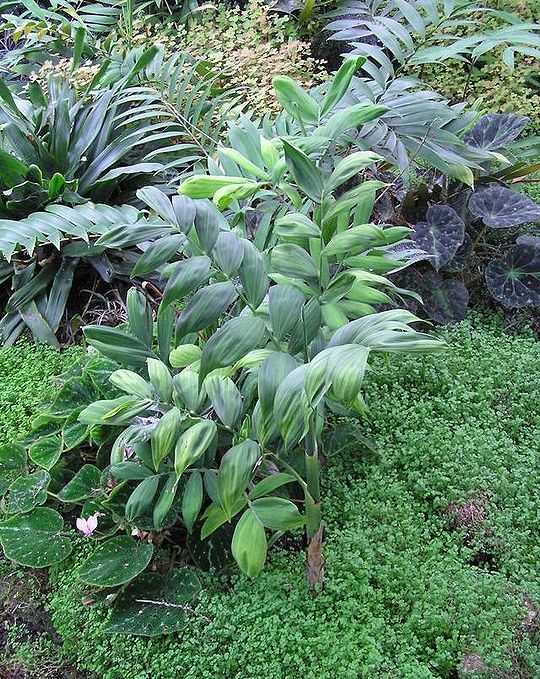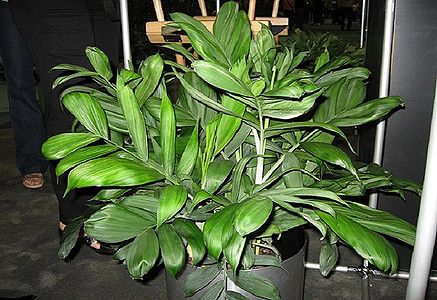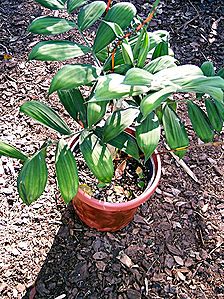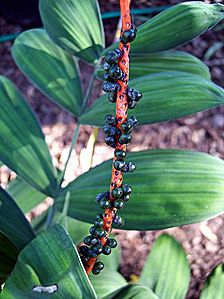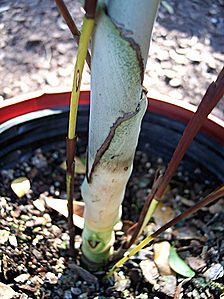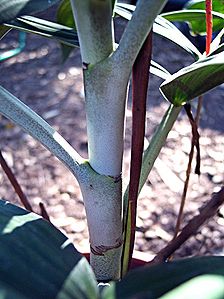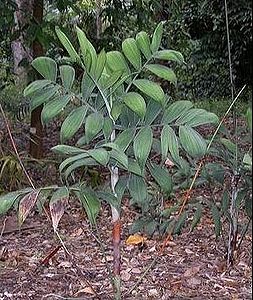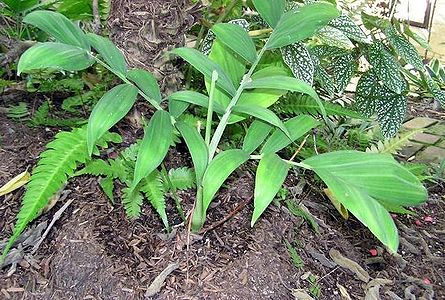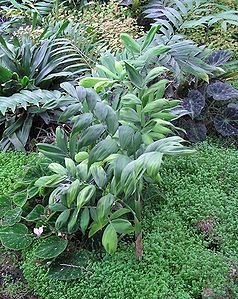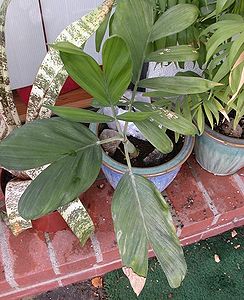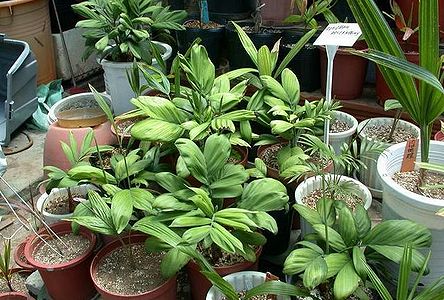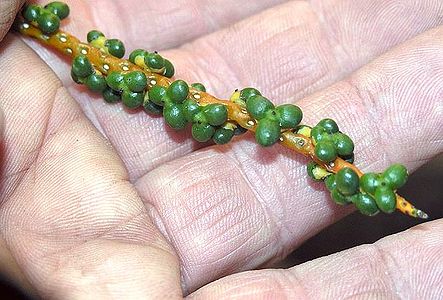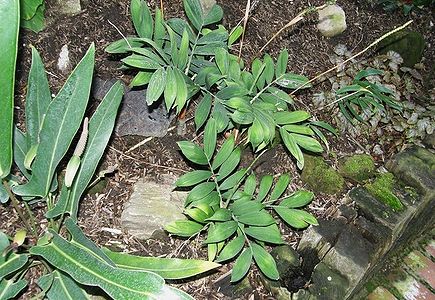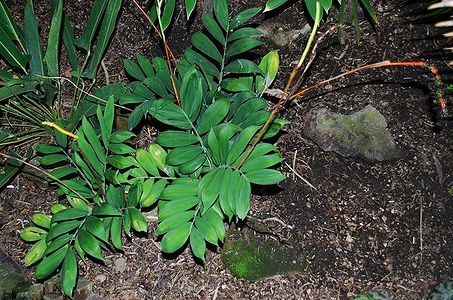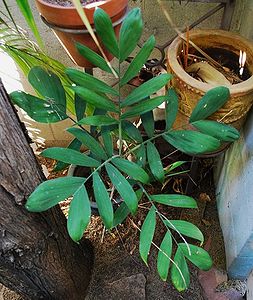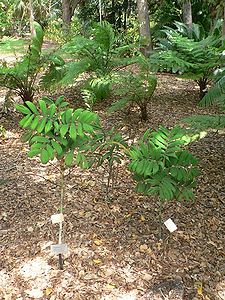Chamaedorea adscendens
<google>CH02</google>
| Chamaedorea (kam-eh-doh-REH-ah) adscendens (ahd-SEN-denz) | |||||||
|---|---|---|---|---|---|---|---|
 Photo-Seabreezenurseries.com, edric. | |||||||
| Scientific Classification | |||||||
| |||||||
| Synonyms | |||||||
|
| |||||||
| Native Continent | |||||||
|
| |||||||
| Morphology | |||||||
| |||||||
| Culture | |||||||
|
| |||||||
| Survivability index | |||||||
|
| |||||||
| Common names | |||||||
|
| |||||||
Contents
Habitat and Distribution
GUATEMALA. Alta Verapaz. Peten. BELIZE. Toledo. Moist or wet forest on the Atlantic slope; to 700 m elevation; on limestone.
Description
A small solitary palm to 2.5 m. tall. When young it looks similar to Chamaedorea metallica , but the blades are more deeply incised apically. According to Hodel its durable leathery leaves are perhaps the thickest in this genus. The leaves are blue-grey-green with a velvety aspect, and are just one feature of this very nice palm. Editing by edric.
Habit: solitary, erect, infrequently decumbent, to 2.5 m tall, flowering when appearing stemless. Stem: 1 cm in diam., often creeping and buried in the leaf litter, covered with persistent sheaths, green where exposed, ringed, internodes 2-2.5 cm long. Leaves: 6 per crown, spreading, pinnate or infrequently bifid; sheath to 6 cm long, tubular, becoming obliquely long-open apically, thick, a rounded costa extending from petiole, gray-green; petiole 7 cm long or more, channeled and grayish above, rounded and grayish below; rachis to 16 cm long, angled and grayish above, rounded and grayish below; apex of sheath, petiole and rachis densely white-spotted; pinnae 2-6 on each side of rachis, middle ones largest, these to 16 x 2.5-3.5 cm, lower ones to 8 x 1.2 cm, obovate-Ianceolate, long-acuminate, thick, leathery, velvet-textured, gray and/or metallic-blue-green, contracted basally, regularly or unevenly spaced, ± obscurely nerved, a prominent but scarcely elevated midrib pale below and numerous inconspicuous nerves of lesser orders, terminal pair often much broader and 29- nerved, or sometimes one side undivided; or blade bifid, to 25-30 x 15-20 cm, incised apically to 'h its length, 6-9-nerved. Inflorescences: infrafoliar, penetrating sheaths at nodes, ascending to erect in flower, ascending to spreading in fruit, sometimes appearing to arise from leaf litter, exceeding leaves; peduncles 40-70 cm long, slender, 1.5 cm wide at base, green where exposed in flower, red-orange in fruit; bracts 8-9, tubular, bifid or acuminate, brownish in flower, longitudinally striated, uppermost exceeding peduncle. Staminate with rachis to 10 cm long, green in flower; rachillae 2-10, these to 20 cm long, slender, pendulous, green in flower, lower ones sometimes forked. Pistillate spicate; rachis or flower-bearing portion to 15 cm long, green in flower, red in fruit. Flowers: Staminate in dense spirals but not contiguous in bud, 2-2.5 x 2-2.5 mm, ± globose, bright yellow, ageing to cream-colored, ± superficial on axis; calyx 0.5-1 x 2-2.5 mm, shallowly lobed, pale, membranous, sepals connate nearly to apex and there ± truncate; petals 2-3 x 1.5-2.5 mm, ovate, valvate, free nearly to base, spreading apically, acute; stamens 1-1.5 mm tall, filiments short or nearly lacking, anthers 1-1.25 mm long, entire apically; pistillode just exceeding stamens but shorter than petals, columnar. Pistillate in moderate spirals, 2-2.5 x 1.5-1.75 mm, ovoid-globose, only slightly sunken; calyx 0.75-1 x 1.75-2.25 mm, ± deeply lobed, sepals connate and/or imbricate in basal 1/4-1/2, broadly rounded apically, obtuse; petals 2-2.5 x 2 mm, briefly connate basally, imbricate nearly to apex, broadly rounded, acute-obtuse, minutely black-spotted apically, very faintly nerved on outside when dry; staminodes lacking or present; pistil 1.5-2 x 1.5-1.75 mm, conic, stigma lobes sessile, recurved. Fruits: 8 mm in diam. or long, globose or ovoid, black; seeds 6 mm long; abortive carpels adherent to corolla in fruit. (Hodel, D.R. 1992) Editing by edric.
Dammer (l905a) described and named C. adscendens from material that Tuerckheim had collected near Cubilguitz, Alta Verapaz, Guatemala. Dammer erected a new genus, Kinetostigma, for the species and later Burret (l933a) formally transferred it to Chamaedorea. C. adscendens is a remarkable palm in habit and habitat. Its durable, leathery leaves are perhaps the thickest in the genus, and their velvety texture and blue-gray-green color are attractive features. Although leaves are usually pinnate, bifid leaved individuals are not uncommon. Young plants with bifid leaves are similar to C. metallica except the blades are more deeply incised apically. The habitat of C. adscendens is unusual also. Like C. graminifolia, the species appears restricted to the summits of steep limestone hills. In fact, the two species occasionally occur together. Only a thin layer of leaf litter covers the limestone rock and the area can experience a rather lengthy dry period. In 1991 during the height of the dry season, we found C. adscendens in southern Peten on solid limestone rock. While other dicotyledonous shrubs and trees were actually wilting from the lack of water, C. adscendens seemed to be unaffected. C. adscendens is rare in the wild; only a few collections in several herbaria document it, and we searched for it in the wild on four occasions before finally finding it in Guatemala. C. adscendens does not occur at the summit of each hill in a given area; it is often quite localized on a particular hill. Although we searched a half-dozen hills within a small area, we found C. adscendens only on one of these, and then it was confined to only a small portion of the summit. It is difficult to explain this unusual distribution. Staminate inflorescences at anthesis are densely flowered, resembling such species as C. arenbergiana and C. tepejilote of subgenus Stephanostachys; however, flowers are clearly distinct in bud. Although Moore (1963, 1976) indicated that C. adscendens was cultivated, it is doubtful if this is still true. Plants cultivated at Fairchild Tropical Garden under this name, and originally collected in the Jacinto Hills in Belize died several years ago. Apparently the only plants in cultivation now, are the few small ones in the research collection in Los Angeles. (Hodel, D.R. 1992)
Culture
Warm, sheltered and moist. Likes mulch.
Comments and Curiosities
Chamaedorea are dioecious, male, and female flowers, on separate plants.
Etymology: Is a Latin word meaning ascending, apparently in reference to the inflorescences although the author did not specify the application of the name.
External Links
References
Phonetic spelling of Latin names by edric.
Special thanks to Geoff Stein, (Palmbob) for his hundreds of photos, edric.
Special thanks to palmweb.org, Dr. John Dransfield, Dr. Bill Baker & team, for their volumes of information and photos, edric.
- IMAGE GALLERY
Many Special Thanks to Ed Vaile for his long hours of tireless editing and numerous contributions.
